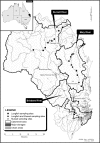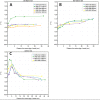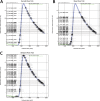Age structure of the Australian lungfish (Neoceratodus forsteri)
- PMID: 30673738
- PMCID: PMC6343868
- DOI: 10.1371/journal.pone.0210168
Age structure of the Australian lungfish (Neoceratodus forsteri)
Abstract
The Australian lungfish has been studied for more than a century without any knowledge of the longevity of the species. Traditional methods for ageing fish, such as analysis of otolith (ear stone) rings is complicated in that lungfish otoliths differ from teleost fish in composition. As otolith sampling is also lethal, this is not appropriate for a protected species listed under Australian legislation. Lungfish scales were removed from 500 fish from the Brisbane, Burnett and Mary rivers. A sub-sample of scales (85) were aged using bomb radiocarbon techniques and validated using scales marked previously with oxytetracycline. Lungfish ages ranged from 2.5-77 years of age. Estimated population age structures derived using an Age Length Key revealed different recruitment patterns between river systems. There were statistically significant von Bertalanffy growth model parameters estimated for each of the three rivers based on limited sample sizes. In addition, length frequency distributions between river systems were also significantly different. Further studies will be conducted to review drivers that may explain these inter-river differences.
Conflict of interest statement
The authors have declared that no competing interests exist in considering their commercial partner. This does not alter the authors' adherence to PLOS ONE policies on sharing data and materials.
Figures












References
-
- Pusey BJ, Kennard M and Arthington A. Freshwater fishes of North-eastern Australia. Collingwood. Centre for Riverine Landscapes, Griffith University: CSIRO Publishing; 2004.
-
- Arthington AH. Australian lungfish, Neoceratodus forsteri, threatened by a new dam. Environ Biol Fishes 2009;84(2):211–221.
-
- Kind PK. The General Natural History of the Australian lungfish Neoceratodus forsteri (Krefft 1870) In Morup Jorgensen J, Joss J, editors. Biology of Lungfishes. Australia: CRC Press; 2010: pp. 61–95.
-
- Villamor B, Gonzalez-Pola C, Lavín A, Valdés L, Lago De Lanzós A, Franco C, et al. Environmental control of Northeast Atlantic mackerel (Scomber scombrus) recruitment in the southern Bay of Biscay: Case study of failure in the year 2000. Fish Oceanogr 2011;20(5):397–414.
Publication types
MeSH terms
LinkOut - more resources
Full Text Sources
Research Materials

